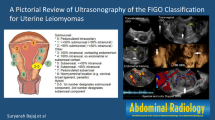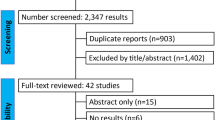Abstract
Purpose
To analyze reoperation rates and perioperative outcomes after long-term follow-up of two surgical approaches in the treatment of endometrial cancer when the standard of care shifts from open surgery to laparoscopy at a university hospital.
Methods
In this retrospective monocenter study a total of 267 patients with endometrial cancer were included; 107 women underwent laparoscopy and 160 laparotomy. All of the patients received total hysterectomy, bilateral salpingo-oophorectomy, and pelvic and para-aortic lymphadenectomy, depending on individual pathological features (e.g. high risk for positive lymph nodes) and the expertise of the surgeon.
Results
Repeat surgery was needed significantly more often in the laparotomy group in comparison with the laparoscopy group (11.9 vs. 0.9 %, respectively; P < 0.001). Hospital stays were longer in the laparotomy group in comparison with laparoscopy (16.2 vs. 9.5 days; P < 0.000001). Postoperative complications were significantly more frequent in the laparotomy group in comparison with laparoscopy (25.0 vs. 10.3 %; P < 0.01). Operating times and preoperative and postoperative hemoglobin differences were similar in the two groups (193.9 vs. 190.6 min, 2.0 vs. 1.8 g/dl). Intraoperative complication rates were similar in the two groups (3.8 vs. 5.6 %).
Conclusions
Laparoscopy is a safe alternative to laparotomy for low risk endometrial cancer patients and offers markedly improved perioperative outcomes with a lower reoperation rate and fewer postoperative complications when the standard of care shifts from open surgery to laparoscopy in a university hospital.

Similar content being viewed by others
References
Parkin DM, Bray F, Ferlay J, Pisani P (2005) Global cancer statistics, 2002. CA Cancer J Clin 55(2):74–108
Wright JD, Barrena Medel NI, Sehouli J, Fujiwara K, Herzog TJ (2012) Contemporary management of endometrial cancer. Lancet 379(9823):1352–1360
Janda M, Gebski V, Brand A, Hogg R, Jobling TW, Land R, Manolitsas T, McCartney A, Nascimento M, Neesham D, Nicklin JL, Oehler MK, Otton G, Perrin L, Salfinger S, Hammond I, Leung Y, Walsh T, Sykes P, Ngan H, Garrett A, Laney M, Ng TY, Tam K, Chan K, Wrede CD, Pather S, Simcock B, Farrell R, Obermair A (2010) Quality of life after total laparoscopic hysterectomy versus total abdominal hysterectomy for stage I endometrial cancer (LACE): a randomised trial. Lancet Oncol 11(8):772–780
Mourits MJ, Bijen CB, Arts HJ, ter Brugge HG, van der Sijde R, Paulsen L, Wijma J, Bongers MY, Post WJ, van der Zee AG, de Bock GH (2010) Safety of laparoscopy versus laparotomy in early-stage endometrial cancer: a randomised trial. Lancet Oncol 11(8):763–771
Walker JL, Piedmonte MR, Spirtos NM, Eisenkop SM, Schlaerth JB, Mannel RS, Spiegel G, Barakat R, Pearl ML, Sharma SK (2009) Laparoscopy compared with laparotomy for comprehensive surgical staging of uterine cancer: Gynecologic Oncology Group Study LAP2. J Clin Oncol 27(32):5331–5336
Mueller A, Thiel F, Lermann J, Oppelt P, Beckmann MW, Renner SP (2010) Feasibility and safety of total laparoscopic hysterectomy (TLH) using the Hohl instrument in nonobese and obese women. J Obstet Gynaecol Res 36(1):159–164
Cho YH, Kim DY, Kim JH, Kim YM, Kim YT, Nam JH (2007) Laparoscopic management of early uterine cancer: 10-year experience in Asan Medical Center. Gynecol Oncol 106(3):585–590
Wallwiener D, Jonat W, Kreienberg R, Friese K, Diedrich K, Beckmann MW (2009) Atlas der gynäkologischen Operationen, 7th edn. Thieme, Stuttgart
Mueller A, Oppelt P, Binder H, Ackermann S, Beckmann MW (2005) The “Hohl instrument” for optimizing total laparoscopic hysterectomy procedures. J Minim Invasive Gynecol 12:432–435
Pecorelli S (2009) Revised FIGO staging for carcinoma of the vulva, cervix, and endometrium. Int J Gynaecol Obstet 105(2):103–104
Perrone AM, Di Marcoberardino B, Rossi M, Pozzati F, Pellegrini A, Procaccini M, Santini D, De Iaco P (2012) Laparoscopic versus laparotomic approach to endometrial cancer. Eur J Gynaecol Oncol 33(4):376–381
Galaal K, Bryant A, Fisher AD, Al-Khaduri M, Kew F, Lopes AD (2012) Laparoscopy versus laparotomy for the management of early stage endometrial cancer. Cochrane Database Syst Rev 9:CD006655
Juhasz-Böss I, Haggag H, Baum S, Kerl S, Rody A, Solomayer E (2012) Laparoscopic and laparotomic approaches for endometrial cancer treatment: a comprehensive review. Arch Gynecol Obstet 286(1):167–172
Mueller A, Boosz A, Koch M, Jud S, Faschingbauer F, Schrauder M, Löhberg C, Mehlhorn G, Renner SP, Lux MP, Beckmann MW, Thiel FC (2012) The Hohl instrument for optimizing total laparoscopic hysterectomy: results of more than 500 procedures in a university training center. Arch Gynecol Obstet 285(1):123–127
Müller A, Thiel FC, Renner SP, Winkler M, Häberle L, Beckmann MW (2010) Hysterectomy—a comparison of approaches. Dtsch Arztebl Int 107(20):353–359
Mueller A, Renner SP, Haeberle L, Lermann J, Oppelt P, Beckmann MW, Thiel F (2009) Comparison of total laparoscopic hysterectomy (TLH) and laparoscopy-assisted supracervical hysterectomy (LASH) in women with uterine leiomyoma. Eur J Obstet Gynecol Reprod Biol 144(1):76–79
Boosz A, Lermann J, Mehlhorn G, Loehberg C, Renner SP, Thiel FC, Schrauder M, Beckmann MW, Mueller A (2011) Comparison of re-operation rates and complication rates after total laparoscopic hysterectomy (TLH) and laparoscopy-assisted supracervical hysterectomy (LASH). Eur J Obstet Gynecol Reprod Biol 158(2):269–273
Querleu D, Leblanc E, Cartron G et al (2006) Audit of preoperative and early complications of laparoscopic lymph node dissection in 1000 gynecologic cancer patients. Am J Obstet Gynecol 195:1287–1292
Terai Y, Tanaka T, Sasaki H, Kawaguchi H, Fujiwara S, Yoo S, Tanaka Y, Tsunetoh S, Kanemura M, Ohmichi MJ (2014) Total laparoscopic modified radical hysterectomy with lymphadenectomy for endometrial cancer compared with laparotomy. Obstet Gynaecol Res 40(2):570–575
Lu Q, Liu H, Liu C, Wang S, Li S, Guo S, Lu J, Zhang Z (2013) Comparison of laparoscopy and laparotomy for management of endometrial carcinoma: a prospective randomized study with 11-year experience. J Cancer Res Clin Oncol 139(11):1853–1859
Tahmasbi Rad M, Wallwiener M, Rom J, Sohn C, Eichbaum M (2013) Learning curve for laparoscopic staging of early and locally advanced cervical and endometrial cancer. Arch Gynecol Obstet 288(3):635–642
De Wilde RL, Rafei A, Herrmann A (2014) Can a lymphadenectomy be avoided in early-stage endometrial adenocarcinoma? Arch Gynecol Obstet [Epub ahead of print]
Tinelli R, Litta P, Meir Y, Surico D, Leo L, Fusco A, Angioni S, Cicinelli E (2014) Advantages of laparoscopy versus laparotomy in extremely obese women (BMI >35) with early-stage endometrial cancer: a multicenter study. Anticancer Res 34(5):2497–2502
Rabischong B, Larraín D, Canis M, Le Bouëdec G, Pomel C, Jardon K, Kwiatkowski F, Bourdel N, Achard JL, Dauplat J, Mage G (2011) Long-term follow-up after laparoscopic management of endometrial cancer in the obese: a fifteen-year cohort study. J Minim Invasive Gynecol 18(5):589–596
Frey MK, Ihnow SB, Worley MJ Jr, Heyman KP, Kessler R, Slomovitz BM, Holcomb KM (2011) Minimally invasive staging of endometrial cancer is feasible and safe in elderly women. J Minim Invasive Gynecol 18(2):200–204
Bogani G, Cromi A, Uccella S, Serati M, Casarin J, Mariani A, Ghezzi F (2014) Laparoscopic staging in women older than 75 years with early-stage endometrial cancer: comparison with open surgical operation. Menopause [Epub ahead of print]
Conflict of interest
The authors have nothing to disclose.
Author information
Authors and Affiliations
Corresponding author
Rights and permissions
About this article
Cite this article
Boosz, A., Haeberle, L., Renner, S.P. et al. Comparison of reoperation rates, perioperative outcomes in women with endometrial cancer when the standard of care shifts from open surgery to laparoscopy. Arch Gynecol Obstet 290, 1215–1220 (2014). https://doi.org/10.1007/s00404-014-3347-9
Received:
Accepted:
Published:
Issue Date:
DOI: https://doi.org/10.1007/s00404-014-3347-9




